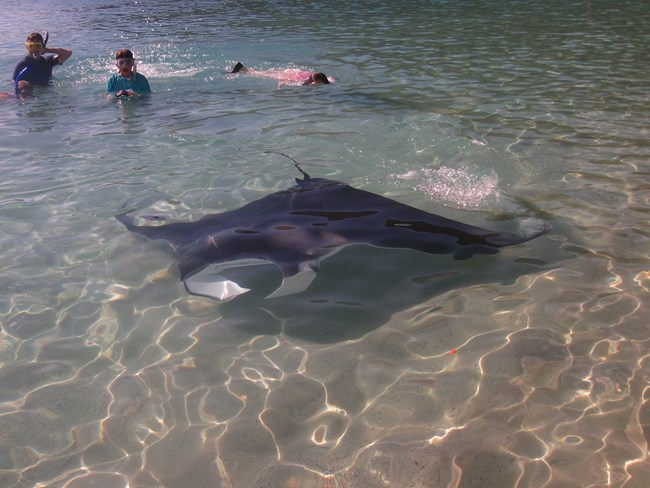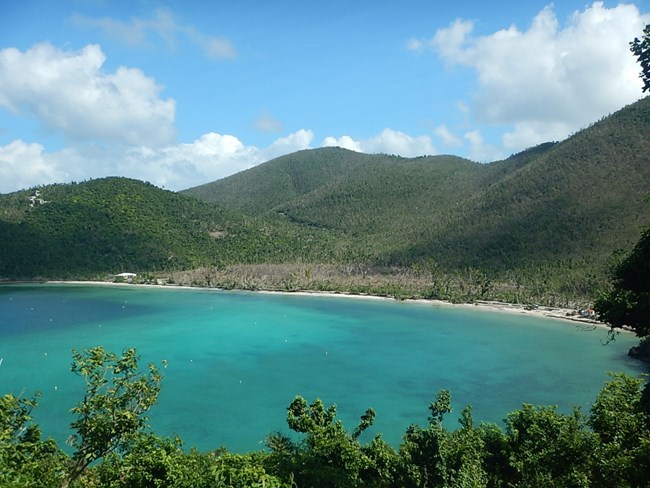Part of a series of articles titled Park Air Profiles.
Article
Park Air Profiles - Virgin Islands National Park
Air Quality at Virgin Islands National Park
Most visitors expect clean air and clear views in parks. Virgin Islands National Park (NP), U.S. Virgin Islands, is known for its white sandy beaches, crystal blue-green waters, coral reefs, hills, and valleys. This remote area’s air quality is affected by occasional Saharan dust events and upwind urban and industrial sources. Air pollutants blown into the park can harm natural and scenic resources such as soils, surface waters, plants, wildlife, and visibility. The National Park Service works to address air pollution effects at Virgin Islands NP, and in parks across the U.S., through science, policy and planning, and by doing our part.
Nitrogen and Sulfur

Nitrogen and sulfur compounds deposited from the air may have harmful effects on surface waters, marine environments, and vegetation similar to those found at Virgin Islands NP. While the freshwater and saltwater ecosystems at Virgin Islands NP are generally well-buffered from these effects, nitrogen and sulfur can contribute to ocean acidification. Ocean acidification is known to contribute to coral death, also known as coral “bleaching.” Additionally, small streams in narrow valleys with steep-sided watersheds in the park have little ability to retain nutrients and water, offering the landscape little opportunity to buffer potentially acidic run-off (Sullivan et al. 2011c; Sullivan et al. 2011d).
Excess nitrogen can also lead to nutrient enrichment, a process that changes nutrient cycling and alters plant communities. Ecosystem sensitivity to nutrient enrichment at the park is considered very very low (Sullivan et al. 2011a; Sullivan et al. 2011b). Still, wetland plant species adapted to low nitrogen environments in protected bays, estuaries, and valley streams may be sensitive to nutrient enrichment. As nitrogen in the environment increases, species relationships may be altered, sometimes increasing the establishment of non-native species at the expense of the rare species.
Healthy ecosystems can naturally buffer a certain amount of pollution, but as nitrogen and sulfur accumulate, a threshold is passed where the ecosystem is harmed. “Critical load” is a term used to describe the amount of pollution above which harmful changes in sensitive ecosystems occur (Porter 2005). Nitrogen deposition exceeds the critical load for one or more park ecosystems (NPS ARD 2018).
Visit the NPS air quality conditions and trends website for park-specific nitrogen and sulfur deposition information. Virgin Islands NP has been monitoring nitrogen and sulfur since 1999. Explore air monitoring »
Persistent Pollutants
Pollutants like mercury and pesticides are concerning because they are persistent and toxic in the environment. These contaminants can travel in the air thousands of miles away from the source of pollution, even depositing in protected places like national parks. In addition, while some of these harmful pollutants may be banned from use, historically contaminated sites continue to endure negative environmental consequences.
When deposited, airborne mercury and other toxic air contaminants are known to harm wildlife like birds and fish, and cause human health concerns. Many of these substances enter the food chain and accumulate in the tissue of organisms causing reduced reproductive success, impaired growth and development, and decreased survival.
Contaminants, including pesticides like DDT, were found in low to moderate concentrations in sediment samples from the Salt River Bay National Historical Park and Ecological Preserve (Pait et al. 2020).
Dragonfly larvae have been sampled from five sites on St. John and St. Croix. Results of mercury analyses are pending (Eagles-Smith et al. 2018; Eagles-Smith et al. 2020).
The NPS Air Resources Division reports on park conditions and trends for mercury. Visit the webpage to learn more. Fish consumption advisories may be in effect for mercury and other contaminants (NPS 2022).
Visibility

Visitors come to Virgin Islands NP to enjoy breathtaking beaches, marine life, coral reefs, and steep-sided hills and valleys. Park vistas are sometimes obscured by haze, reducing how well and how far people can see. Visibility reducing haze is caused by tiny particles in the air, and these particles can also affect human health. Many of the same pollutants that ultimately fall out as nitrogen and sulfur deposition contribute to this haze. Organic compounds, soot, and dust reduce visibility as well. No significant improvements in park visibility have been documented. In fact, long term trends suggest that since 2001 park visibility has been getting worse. Overall, visibility in the park still needs significant improvement to reach the Clean Air Act goal of no human caused impairment.
Airborne Dust Impacts on Marine Environments
The tradewinds blowing across the tropical Atlantic ocean bring millions of tons of dust from the Sahara and Sahel regions of Africa to the Caribbean every year. The dust that reaches the Caribbean limits visibility and research indicates that this dust also contains viable bacteria and fungi, nutrients, metals, and persistent organic pollutants (e.g., pesticides, PAHs, PCBs) (Garrison et al. 2006, Kellogg and Griffin 2006). A particular soil fungus detected, Aspergillus sydowii, causes sea fan disease and results in widespread coral mortality. The NPS coordinates with scientists from agencies including USGS and NASA to study the connections between atmospheric dust events and the health of coral reefs. View a documentary on African dust, coral reefs, and human health to learn more.
Visibility effects:
- Reduced visibility, at times, due to African dust or human-caused haze from fine particles of air pollution;
- Reduction of the average natural visual range from about 120 miles (without pollution) to about 65 miles because of pollution at the park;
- Reduction of the visual range to below 40 miles on high pollution days.
Visit the NPS air quality conditions and trends website for park-specific visibility information. Virgin Islands NP has been monitoring visibility since 1990. Explore air monitoring »
Explore Other Park Air Profiles
There are 47 other Park Air Profiles covering parks across the United States and its territories.
References
Eagles-Smith, C.A., S.J. Nelson., C.M. Flanagan Pritz, J.J. Willacker Jr., and A. Klemmer. 2018. Total Mercury Concentrations in Dragonfly Larvae from U.S. National Parks (ver. 6.0, June 2021): U.S. Geological Survey data release. https://doi.org/10.5066/P9TK6NPT
Eagles-Smith, C.A., J.J. Willacker, S.J. Nelson, C.M. Flanagan Pritz, D.P. Krabbenhoft, C.Y. Chen, J.T. Ackerman, E.H. Campbell Grant, and D.S. Pilliod. 2020. Dragonflies as biosentinels of mercury availability in aquatic food webs of national parks throughout the United States. Environmental Science and Technology 54(14):8779-8790. https://doi.org/10.1021/acs.est.0c01255
Garrison, V. H., Foreman, W. T., Genualdi, S., Griffin, D. W., Kellogg, C. A., Majewski, M. S., Mohammed, A., Ramsubhag, A., Shinn, E. A., Simonich, S. L., and Smith, G. W. 2006. Saharan dust - a carrier of persistent organic pollutants, metals and microbes to the Caribbean? Rev. Biol. Trop. (Int. J. Trop. Biol.) 54 (Suppl. 3): 9–21.
Kellogg, C. A. and Griffin, D. W. 2006. Aerobiology and the global transport of desert dust. Trends in Ecology & Evolution 21 (11): 63–644.
Kohut R.J. 2007. Ozone Risk Assessment for Vital Signs Monitoring Networks, Appalachian National Scenic Trail, and Natchez Trace National Scenic Trail. NPS/NRPC/ARD/NRTR—2007/001. National Park Service. Fort Collins, Colorado. Available at https://www.nps.gov/articles/ozone-risk-assessment.htm
National Park Service (NPS). 2022. Fish Consumption Advisories. https://www.nps.gov/subjects/fishing/fish-consumption-advisories.htm
Pait, A.S., S.I. Hartwell, and D.A. Apeti. 2020. An assessment of chemical contaminants, toxicity and benthic infauna in sediments from the Salt River Bay National Historical Park and Ecological Preserve, St. Croix, US Virgin Islands. NOS NCCOS 290. Silver Spring, MD. 57 pp. https://doi.org/10.25923/32am-hn50
Porter, E., Blett, T., Potter, D.U., Huber, C. 2005. Protecting resources on federal lands: Implications of critical loads for atmospheric deposition of nitrogen and sulfur. BioScience 55(7): 603–612. https://doi.org/10.1641/0006-3568(2005)055[0603:PROFLI]2.0.CO;2
Sullivan, T. J., McDonnell, T. C., McPherson, G. T., Mackey, S. D., Moore, D. 2011a. Evaluation of the sensitivity of inventory and monitoring national parks to nutrient enrichment effects from atmospheric nitrogen deposition: main report. Natural Resource Report NPS/NRPC/ARD/NRR—2011/313. National Park Service, Denver, Colorado. Available at https://www.nps.gov/articles/nitrogen-risk-assessment.htm
Sullivan, T. J., McDonnell, T. C., McPherson, G. T., Mackey, S. D., Moore, D. 2011b. Evaluation of the sensitivity of inventory and monitoring national parks to nutrient enrichment effects from atmospheric nitrogen deposition: South Florida/Caribbean Network (SFCN). Natural Resource Report NPS/NRPC/ARD/NRR—2011/330. National Park Service, Denver, Colorado. Available at https://irma.nps.gov/DataStore/Reference/Profile/2168780.
Sullivan, T. J., McPherson, G. T., McDonnell, T. C., Mackey, S. D., Moore, D. 2011c. Evaluation of the sensitivity of inventory and monitoring national parks to acidification effects from atmospheric sulfur and nitrogen deposition: main report. Natural Resource Report NPS/NRPC/ARD/NRR—2011/349. National Park Service, Denver, Colorado. Available at https://www.nps.gov/articles/acidification-risk-assessment.htm
Sullivan, T. J., McPherson, G. T., McDonnell, T. C., Mackey, S. D., Moore, D. 2011d. Evaluation of the sensitivity of inventory and monitoring national parks to acidification effects from atmospheric sulfur and nitrogen deposition: South Florida/Caribbean Network (SFCN). Natural Resource Report NPS/NRPC/ARD/NRR—2011/377. National Park Service, Denver, Colorado. Available at https://irma.nps.gov/DataStore/Reference/Profile/2170607.
Sullivan T.J. 2016. Air quality related values (AQRVs) in national parks: Effects from ozone; visibility reducing particles; and atmospheric deposition of acids, nutrients and toxics. Natural Resource Report. NPS/NRSS/ARD/NRR—2016/1196. National Park Service. Fort Collins, Colorado. Available at https://www.nps.gov/articles/aqrv-assessment.htm.
Last updated: August 17, 2023
